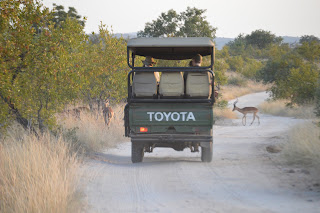I have always dreamed of going on safari in Africa, but believed it to be out of my reach: too far, too expensive, too difficult to arrange. Of course, I was thinking of the old idea of safaris that took the upperclass into the bush for weeks, taking with them all the trappings for a luxury camping trip. Most safaris are now more affordable, and easily booked online. Still, if it hadn't been for some friends planning a trip to South Africa for a safari over our spring break, I don't think I would have considered a budget 4 day safari. It didn't have a rustic appeal of Kenya or Tanzania, but I still believe if was the best option for us due to several factors, and I would like to outline the advantages of this sort of safari for others, like me, who have always thought of an African safari as an unobtainable dream.

Getting there: Johannesburg is a direct flight from Europe, or with a short stopover in Addis Ababa or Doha. We were even able to use our air miles to purchase flights, which made the whole trip even more affordable. Johannesburg has not much else going for it other than its proximity to Kruger National Park, which is roughly the size the nation of Israel. Since the closing of the park due to COVID restrictions, the area has been hurting for tourism, and we found hotel prices very affordable. We could have checked into an airport hotel for a short nap and shower for $30, but we waited comfortably in one of the many restaurants and cafes at O R Tambo international airport. The safari had asked us to arrive early in order to be picked up at 9 am for our trip to Kruger, which took 6 hours with several stops for food and driver changes. Originally, I had considered hiring a car at the airport and driving ourselves around. I know several others who did this, but out of Cape Town. I see now, that in order to see the Big 5 animals, you really need to book a tour safari that will take you to where the animals are, in a short amount of time. If we had more time, we could have driven around Kruger Park, but any animals we chanced to see would be far off in the bush.

Game Drives: Our safari people offered transport to and from Jo'burg, accommodation, meals and game drives. These took place on private land where expert guides keep track of where the animals are. Recently there has been a move to remove all fences on private land that backs on to the national park, to allow animals to roam freely. The only exception are those game reserves for hunting purposes. Our drives took us across several private properties, but skirted the hunting zones. The first night we arrived at our lodge, we were taken out for a sunset game drive. There were 10 of us in an open sided jeep, bumping down dirt tracks, and off-roading through the grass. We immediately saw a lone male elephant, that ignored us and kept munching on leaves and branches.

Then we started to see antelope which we wrongly identified as 'deer'. The impala are the most prevalent, with their characteristic "M" rear end markings, and the tiny slimbok are harder to see because of their size in the long grass. As the sun set we saw two giraffe, but our guide did not slow down or try to approach because he had just heard from another guide of the location of the lions. Sure enough, we encountered the pride lying down in the road, paying no heed to the several jeeps of tourists who were all trying to photograph them in the dying light.

Accommodation: The private lodges near the park give the experience of staying the night 'in the bush' due to the absence of fences to keep the animals out. There are monkeys always lurking in the trees ready to steal your breakfast or ransack your room. Impala and nyala antelope will wander poolside. The outdoor barbecue attracted two hyena which we picked out with our flashlights shining into the bush. The second night we were moved to even more rustic accommodation, advertised as 'tree houses'. Due to their open sides, we had bugs, frogs, and rodents crawling around inside. Outside, along the pathways to and from the dining room, we saw giraffe and buffalo, while hearing the roars of lions nearby.

Kruger National Park: Only one day did we travel into the park, where we had to follow the COVID guidelines of registering our name and temperature before entering. Here, our guide took us on a network of paved roads, occasionally stopping so we could watch groups of elephants, zebra, giraffe, wildebeest and other antelope. After a lunch stop we got a tip of where to find some lions, but they were lying down in the long grass quite a distance away and didn't really do much. The sheer size of the park, with its wide open landscape of bush and twisted trees, large groups of grazing animals and waterholes, birds and the occasional large beast on the road, makes the experience worthwhile. I hear that Kruger has more variety than other parks in S.Africa, but you won't get up close to them, like we did on private land.
I intend to write a series of blogs that look in more detail at our budget safari experience in South Africa, but I am convinced that we were fortunate enough to have a positive experience which is making us consider spending more time and money of another safari in the future!






















